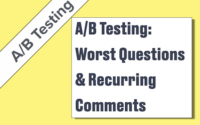How A/B Testing Can Revolutionize Your Business?
Summary
The launch of an optimization program (A/B testing program) requires a mindset change within the company. It will require more team work, methods and, reflection. Both business and people will get the benefits.
In this article, I use the terms “A/B Testing” and “optimization program” indifferently, even though A/B Testing is only the operational part.
Before deciding to launch an optimization program, it’s good to know where you are going. The benefits will be appreciable and measurable, but you will have to know how to manage changes. Here are the 7 challenges I identified when launching an optimization program.
1. Accept the imperfection
Teams must accept the idea that any part of the business can be optimized, that any stage of the customer experience can be suboptimal. Most people agree that the part they are not responsible for can be improved😏. To accept the idea that one’s own work can be improved is to show oneself vulnerable, it’s to take a risk.
2. How much does it cost💸, how much does it bring in💰💰?
Some A/B Test tools are free like Google Analytics, but generally they are paid like Adobe Target.
Doing A/B Testing means taking insurance on the tactical choices you make: any modification to the existing system is tested, measured and analyzed. I can therefore make decisions based on numbers and not based on feelings, impressions or on the highest paid person option (#HIPPO) in the room.
An optimization program is an investment that will return far more than it costs, provided you use it daily.
⚠️ This tool only pays off if you use it. ⚠️
3. Create an Optimization team
Carrying out tests involves several areas of expertise:
- technical: for coding solutions,
- analytical: to understand statistics and use reporting tools,
- archiving: to record what works and what doesn’t.
- It will be necessary to create a team because all of these skills are not necessarily combined in one person.
4. Create a “Culture of Test” among the business teams
Having a “Culture of Test” means being able to say:
- “I don’t know…let’s do a test.” If the corporate culture is favorable to preconceived ideas, to the last one who speaks, or to the one who speaks the loudest, the step is likely to be high.
- “Do we have numbers to make this decision? So, let’s take the time to test it to get data.” If the company culture favors making quick decisions based on instinct, gut feeling, or wet fingers raised in the air, it will take time to adapt.
- The “Culture of Test” does not reject the idea that experienced people can instinctively anticipate market behavior. But trust does not prevent verification, and providing numerical proof in no way devalues the experience but confirms it.
- A “Culture of Test” is about being rational and using numbers to make decisions.
5. Being wrong, staying humble, wanting to improve
When a test is positive, success reflects on the team. When a test is negative, we learn from it. In both cases, we learn about our business.
When a test is a monumental failure, you have to be able to accept the reality of the numbers. Recognize that you have not chosen the right solution, learn from your mistakes, question yourself and move on to the next test.
You must always remain humble in success because failure will arrive eventually (with numerical proofs).
6. Gain a broader understanding of the business and share information
Optimizing means challenging what exists, trying to change certain KPIs. But this is not always without effect on other parts of the business. Sharing your plans also means ensuring that a $1 gain on the left does not cause a $2 loss on the right. An optimization program must be a global project that requires understanding the business as a whole.
7. Be the messenger of bad news
When a test performs negatively, we see a business opportunity disappearing. Above all, we must see that a test saved us from an upcoming failure.
Sometimes a test provides irrefutable proof that the proposed solution is a fiasco. When the idea comes from top management, you have to be tactful in announcing the results.
Key Takeaways:
- Improvement begins with the desire to change and the willingness to act.
- The culture of optimization can be summed up as “I never lose. I either win or I learn something” (Nelson Mandela)
- To those who say “Trust me, it will work.”, we answer “In God we trust, others bring data” (W. Edwards Deming)



